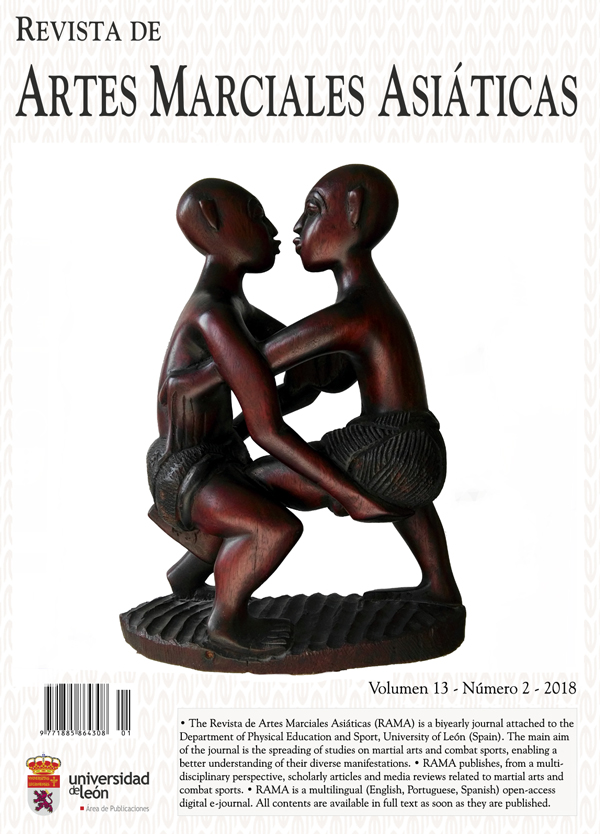Report on the Conference for the 100th Anniversary of Choi Hong Hi: Taekwon-Do and Life; How to View Choi Hong Hi
DOI:
https://doi.org/10.18002/rama.v13i2.5628Keywords:
red complex, International Taekwon-Do Federation (ITF), Taekwondo Promotion Foundation, martial arts, combat sportsAgencies:
Keimyung University (grant #20180269)Abstract
General Choi Hong Hi has long been a controversial figure in the Republic of Korea (ROK; South Korea) despite his extreme influence on Taekwondo. The “Conference for the 100th Anniversary of Choi Hong Hi: Taekwon-Do and Life; How to View Choi Hong Hi” was held on November 28, 2018 at the Korea National Sport University. This report on that conference intends to disseminate the speakers’ findings to a wider audience and establish new directions for academic discussions on International Taekwon-Do Federation (ITF) Taekwon-Do. This conference also illuminated some problems with Taekwondo literature; namely that ITF literature is greatly overshadowed by research on its Olympic counterpart. Additionally, it seems that the only ROK Taekwondo governing body interested in reestablishing General Choi’s legacy is the Taekwondo Promotion Foundation. Nevertheless, even though he was a taboo topic in the ROK a decade ago, the political climate in the ROK has changed and General Choi’s legacy is re-emerging slowly.
Downloads
Métricas alternativas
References
Adrogué, M. E. (2010). ITF Taekwon-Do & sine wave as “sequential motion”. Totally Tae Kwon Do, (15), 19-25.
Cho, M. (2007). From street corners to plaza: The production of festive civic space in Seoul. In M. Douglass, K. C. Ho & G. K. Ooi (eds.), Globalization, the City and Civil Society in Pacific Asia: The Social Production of Civic Spaces (Rethinking Globalizations) (pp. 194-210). London & New York: Routledge.
Choi, H. H. (1987). Encyclopedia of Taekwon-Do, volume 1 (3rd ed.). Mississauga, Canada: International Taekwon-Do Federation.
Choi, H. H. (c2000). Taekwon-Do and I, volume 2: the vision of exile: Any place under heaven is do-jang. N.p.: International Taekwon-Do Federation.
Gillis A. (2016). A killing art: The untold history of Tae Kwon Do – updated and revised edition (1st ed.). Toronto, Canada: ECW Press, Inc.
Heller J., Peric T., Dlouha R., Kohlikova E., Melichna J., & Novakova H. (1998). Physiological profiles of male and female Taekwondo (ITF) black belts. Journal of Sports Sciences, 16(3), 243-249. doi: http://doi.org/10.1080/026404198366768
Heo, I. U. (2015). The study of Taekwondo spirit before the 1960s. Taekwondo Journal of Kukkiwon, 6(1), 1-20.
Johnson, J. A., & Vitale, G. (2018). Taekwondo diplomacy: New possibilities for peace on the Korean Peninsula. Physical Activity Review, 6, 237-250. doi: http://doi.org/10.16926/par.2018.06.28
Kim D. H. (2018, Nov. 3). South and North Korea to integrate respective branches of Taekwondo. Hankyoreh. Retrieved from http://english.hani.co.kr/arti/english_edition/e_northkorea/868668.html?fbclid=IwAR1OOkM3tor9_MVLZMb0ms4gExcdT9Ro1FEjcy96KitKtY5ZWD85a3eHqEI
Kim, D. K., Kim, G. H., & Kim, Y. K. (2004). Choi, Hong Hi and Kim, Un Young’s Taekwondo philosophy and globalization strategy. Philosophy of Movement: The Journal of Korean Philosophic Society for Sport and Dance, 12(2), 363-383. [in Korean].
Korea Foundation. 2013. Taekwondo: The unity of body, mind and spirit. Seoul: Seoul Selection.
Moenig U. (2015). Taekwondo” from a martial art to a combat sport. New York, NY: Routledge.
Moenig U., Cho S., & Kwak T. Y. (2014). Evidence of Taekwondo’s roots in Karate: An analysis of the technical content of early Taekwondo literature. Korea Journal, 54(2), 150-178.
Nishiyama H., & Brown R. C. (1960). Karate: the art of “empty hand” fighting. North Clarendon, VT: Tuttle.
Wąsik J. (2007). The physical basis of the twimyo nomo yop chagi test in Taekwon-Do ITF. Archives of Budo, 3, 82-85.
Wąsik J. (2009). Structure of movement of a turning technique used in the event of special techniques in Taekwon-do ITF. Archives of Budo, 5, 111-115.
Wąsik J. (2011). Kinematics and kinetics of Taekwon-do side kick. Journal of Human Kinetics, 30, 13-20. doi: https://doi.org/10.2478/v10078-011-0068-z
Downloads
Published
How to Cite
Issue
Section
License
Copyright (c) 2018 John A. Johnson, Sanko Lewis

This work is licensed under a Creative Commons Attribution-NonCommercial-ShareAlike 4.0 International License.
The authors who publish in this journal must agree to the following terms:
- The authors grant on a nonexclusive basis the exploitation rights (reproduction, distribution, public communication and transformation) of the work accepted for publication to the University of León. The authors can establish, on their own, additional agreements for the non-exclusive distribution of the version of the work published in the journal (for example, placing it in an institutional repository or publishing it in a book), always acknowledging the initial publication in this journal.
- This work is licensed under the Creative Commons Attribution-NonCommercial-ShareAlike 4.0 International License. Click to see basic information and the legal text of the license.
- The authors are allowed and encouraged to disseminate electronically pre-print or post-print versions of their work before publication, as this can give rise to productive exchanges, as well as earlier and increased citing of the works published.











